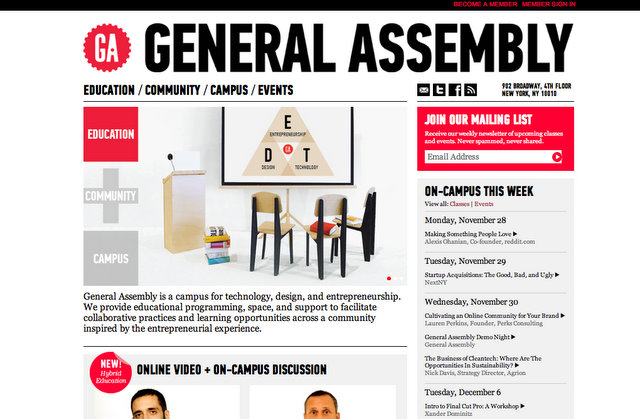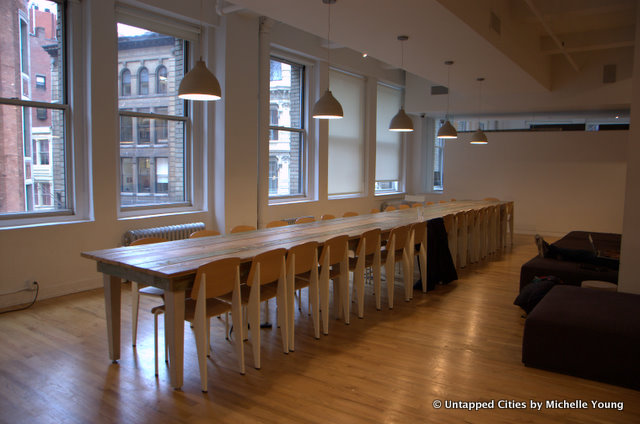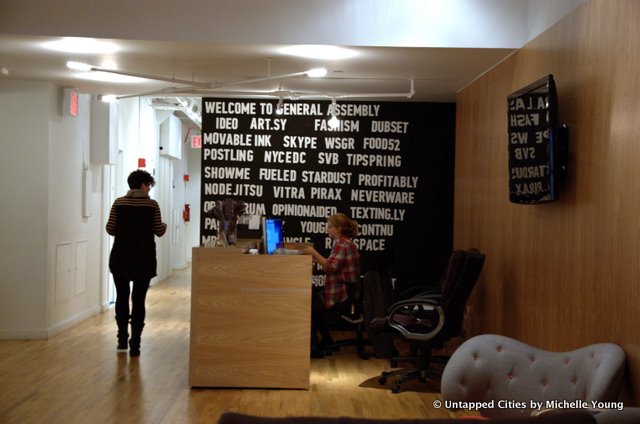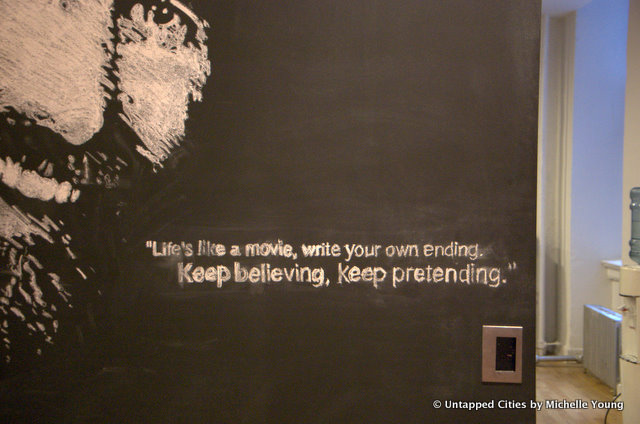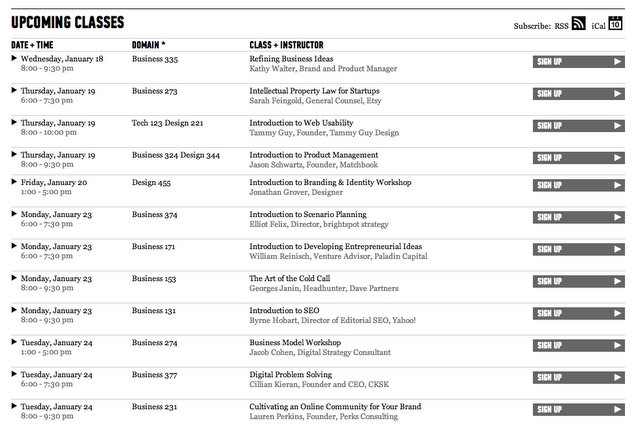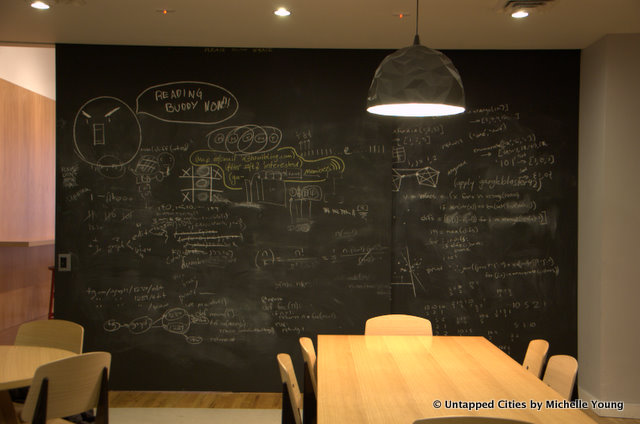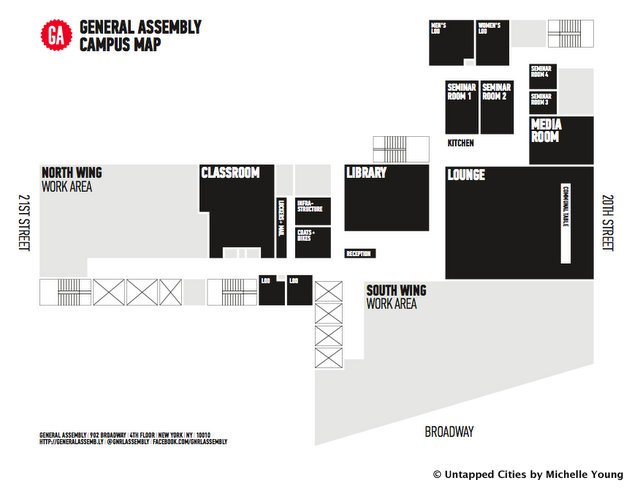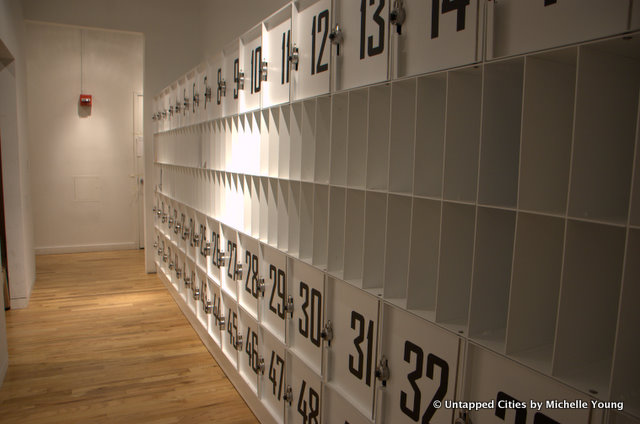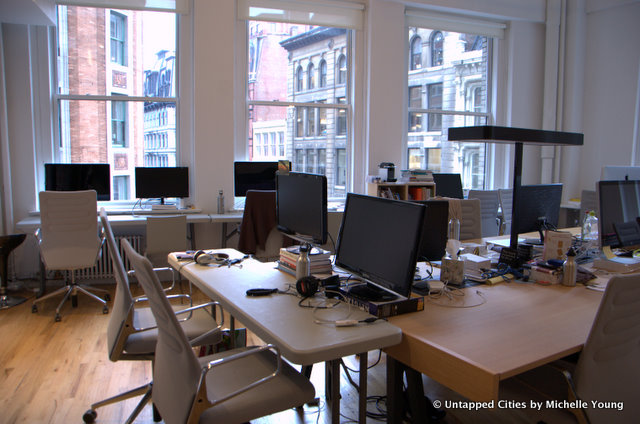With its roots in entrepreneurship, tech startups have naturally gravitated to co-working spaces for financial reasons and as a means to network with like-minded individuals and companies. But co-working can go far beyond what its name implies. One of the most prominent New York spaces, General Assembly, is consciously building a community and educational facility rather than just a shared workspace. This article uncovers what has made General Assembly successful for the numerous stakeholders connected with the company–investors, the city, and the startups themselves. A combination of unique vision, support from the city and developer, speed to market, strong public relations and marketing, along with an educational component has distinguished General Assembly from other co-working facilities in New York City and has made it a valuable entity for outside investors.
General Assembly opened in January 2011 at 902 Broadway in the Flatiron District, initially supported by the New York City Economic Development Corporation, who gave it a $200,000 grant to jump-start its activities. According to General Assembly co-founder Adam Pritzker, the city has a vested interest in the unique educational model being promulgated by his company:
The mayor’s office understands that education around technology and design, and educating a workforce is just a positive thing for the city as a whole. Where big educational institutions aren’t doing a sufficient job of educating the public, I hope we can be a complementary type of pedagogy. [1]
Mayor Bloomberg highlighted job creation, entrepreneurship and the publicly available courses in his statement about General Assembly when it opened. In addition, developers 902 Associates/Jonathan Rosen reportedly gave General Assembly a discount on rent in return for interior improvements. General Assembly signed a 10-year lease at 902 Broadway, a lofty office space dating back to 1913, for $36 per square foot.
The founders were also able to land established companies as key backers, whom they refer to as partners, such as Skype, Ideo, Silicon Valley Bank and Rackspace. Partners and “Dedicated Members” of General Assembly are asked to teach classes and attend events, thus participating in the community. Dedicated members are at General Assembly by invitation only, which gives the company control over the type of full-time tenants that can give back to the community in terms of skills, guidance and industry credibility. The first group of dedicated members at General Assembly included respected entrepreneurs such as Chris Maguire, the founder of Etsy, Amanda Hesser, New York Times food columnist and founder of T Magazine, Chris Hughes, co-founder of Facebook and Jumo, Zach Klein, co-founder of Vimeo, and Mike Yavonditte, CEO of Hashable.
In September of this year, General Assembly raised $4.5 million in a funding round that included the investment funds led by Jeff Bezos of Amazon, Howard Schulz, CEO of Starbucks and venture capitalist Yuri Milner, known for his investments in new social media including Facebook, Twitter, Spotify, Zynga and Groupon. Dave Schappell, founder of TeachStreet and an investor in the September funding round, does not see General Assembly as a tech incubator, but more of an educational company. “The power of the model,” he says, “is that it is very much rooted in community guest lecturers like venture capitalist Fred Wilson or PR guru Brooke Hammerling sharing practical, real-world advice.” [2]
In addition to the educational component, the speed to market for General Assembly is what has also made the company attractive as an investment. Jordan Cooper, partner at Lerer Ventures, a seed stage venture capital fund, says, “It’s amazing how well they’ve executed as a business. They established their position in the market very fast and built a well-oiled product in less than 2 years. If I were looking at an investment in GA (which I haven’t), I’d be thinking about their ability to scale and replicate in other geographies as well as extend their brand online… but one thing is clear…they’ve assembled a team that is capable of getting things done.” [3]
The educational model at General Assembly was initially rooted in a desire to create a space free from venture capital pressure. “The fact that we aren’t venture backed lends itself to an open environment,” co-founder Brad Hargreaves says. “It allows people to be more forthright about issues and to ask the community for help.” [4]
However, the recent funding round raised some questions about whether the investors would be offering the startups at General Assembly seed money, as is practice at tech incubators such as 500 Startups and Y Combinator. But the sentiment is that General Assembly is looking to be more than an incubator, with a desire to build the educational component and expand internationally. Co-founder Brad Hargreaves ruminates on the future of General Assembly on the company blog:
Will we open a bunch more campuses? Put all our classes online? Start training executives? We don’t know. Right now we’re singularly focused on continuing to create a great, meaningful experience at our New York campus. That said, we see the bigger picture: there is immense demand for social, application-driven education in technology, design, and entrepreneurship, and we’re committed to addressing this real need.”
Last month, after Hargreaves’ blog post, General Assembly announced plans to open a 20,000 square foot campus in Shoreditch, London in 2012. The company received an additional investment specifically for the London expansion (the specific amount of the grant was undisclosed) from Yuri Milner, who was involved in the $4.5 million funding round.
Today more than thirty companies work at General Assembly in New York City and a quick glance at its website, generalassemb.ly, reflects the conscious branding and strategy decision that goes beyond providing work space to create an entrepreneurship and educational community. Key to this strategy is to conceive of its office as a “campus” despite its urban location. On its website, General Assembly says it is a “campus for technology, design and entrepreneurship. We provide educational programming, space, and support to facilitate collaborative practices and learning opportunities across a community inspired by the entrepreneurial experience.” The reference to “campus” is dominant on the home page, from the featured image, to the calendar list of what is “on-campus this week,” to videos showing the “on-campus discussion” from the classes held at General Assembly.
On some days, there are up to four classes held at General Assembly. Like at universities, the courses are catalogued in a system and are numbered based on difficulty. But unlike universities, General Assembly can offer new and in demand courses faster. According to Anya Kamenetz of Fast Company, “General Assembly is far more flexible than an Ivy League institution…When its students said they wanted to study Android development, General Assembly ginned up a class two weeks later. A traditional college might take years to meet a new need. This close-to-the-ground, customizable model has been a missing piece of the innovation ecosystem.” [5]
The classes are practical and range from tech, such as an SEO workshop, to public speaking and presentation, to HR & Employment law. As founder Brad Hargreaves writes in the General Assembly blog, “General Assembly has developed classes that are at once social, application-focused, outcome-oriented, and taught by top practitioners. Developing this framework is key to delivering the outcomes our students want: meaningful education in core skills and best practices in technology, design, and entrepreneurship.”
In August, General Assembly began offering a 60-hour, 10-week course that offers certification by General Assembly in Front End Development in basic markup languages like HTML, CSS, jQuery and Javascript. They received over 1000 applications for 15 slots in the $3,000 course, highlighting the demand for this type of skill education outside of a traditional academic environment. The General Assembly educational model also extends beyond members and even the public–companies and institutions are buying classes, providing an additional source of revenue for General Assembly. Wharton Business School hosts a daylong technology and entrepreneurship bootcamp at General Assembly and ad agency KBSP buys classes in bulk as a perk for employees. Finally, the large online potential for the classes has been discussed but not yet publicly in the pipeline.
External communication is also key to the General Assembly strategy. In addition to an ongoing blog on business and education, General Assembly also has a full time public relations firm, BrewPR, managing its press. Some of BrewPR’s other clients have included tech firms such as Zynga, Sirius, Sony, GroupMe and Pulse. In addition, General Assembly has a full time Design Director, Mimi O. Chun, formerly with IDEO, who manages the strategy, marketing and development of General Assembly as a brand. She describes her work at General Assembly as “holistic experience design”:
We began by articulating our mission and the values that define us, and then used them to steer the subsequent development of more concrete touchpoints (e.g. name, identity, web, signage, space) as well as the less tangible aspects of GA (e.g. mechanisms for community-building, partnerships, internal practices). In this next phase, our focus is working with our membership and other practitioners, academics, and thought-leaders to craft a curriculum and content that lies at the intersection of technology, design, and entrepreneurship. [6]
As such, General Assembly’s strategy is seamlessly incorporated into the office space design. Approximately 60% of the 20,000 square foot office is dedicated to communal workspace. The range of workspaces includes an open and light filled lounge, a “library” which is filled with group working tables and a chalkboard wall, seminar rooms, and conference rooms. The lounge has large couches and a long communal table. The kitchen is opened up into the main space, with stools and a chalkboard. Meeting rooms have dry-erase walls and video conferencing capability. At General Assembly, they recognize that ideas and work can occur almost anywhere.
The first thing you see when you get off the elevator is the map of General Assembly. The rooms are additionally categorized by the type of activity that can take place there, from the serious to the whimsical. These activities reflect the range of activities General Assembly feels should be taking place in the facilities and that reading, relaxing, serendipitous conversing and even pillow fighting are all part of the creative process.
The remainder of the space is what they call work areas, for the dedicated members with fixed desks. But even in these work areas, group work is encouraged with an open floor plan and fun couches that provide some privacy. Desks are long with no dividers between. Privacy is not overlooked however, as there are little nooks to take phone calls. Recognizing the mobility of its members, as many are entrepreneurs who come after work, General Assembly has lockers available which double as mailboxes.
There is no mention of pricing for work spaces on the website. Instead, the relevant section is titled “Ways to Engage” with descriptions about the varying levels of membership to General Assembly. Through separate research, I was able to find that the “Communal Membership” is $300/month and provides unlimited access to the lounge 24 hours per day, conference rooms and discounts for classes. “Dedicated Memberships” are for members that work full time and get their own desk. It is twice the price at $600 and such members are admitted by invitation only. The description says, “dedicated members represent the most promising startups in New York and participate in the community by teaching classes, attending events, and working closely with our partners.” An “educational programming” member attends the workshops, classes and events but does not have workspace.
General Assembly hosts events, such as demo nights, tech meetups, gatherings for incoming MBA students and monthly hackathons. Last year, General Assembly hosted a 36-hour hackathon to redesign the new NYC.gov homepage. Mayor Bloomberg greeted the winners of the hackathon just after completion. General Assembly also recently announced a new partnership with General Electric. G.E. will send more than 100 employees to a “digital boot camp” at General Assembly and in turn General Assembly graduates can interview for jobs and internships at G.E.
One General Assembly member we interviewed admits that getting actual work done at General Assembly can be difficult. There are a lot of distractions, including ad-hoc events that require communal members to move around. There is a “constant flux of people in and out, dropping by to say hi, getting introduced”¦so the benefits are clear if you want to be around likeminded people, but it can be a bit of a challenge to be productive,” he says. However he describes General Assembly as a “vibrant community–people love what they do and are proud to be part of a bigger network of entrepreneurs. There is a lot of mutual support and plenty of cross-pollination.” When I asked him what other factors differentiate General Assembly from other coworking spaces he mentioned location, course offerings, general décor and aesthetics. The Flatiron and Union Square area has become a hub for many tech companies and investors so General Assembly is strategically located. The course offerings are diverse and that the speakers that give fireside chats have “industry cred,” which in turn also brings in a lot of outside people into the space for additional networking. But most importantly he says, “being a ‘campus’ for entrepreneurs as opposed to just a coworking space might be [General Assembly’s] secret sauce.”
A lot of other coworking spaces host events, but the branding and public relations of General Assembly in conjunction with events and the caliber of the companies working there have created buzz, press coverage and attention from the tech crowd. The General Assembly member tells Untapped, “Since entrepreneurship can be a lonely endeavor, it helps to be surrounded by those in the same boat. The setup is also great for meeting potential partners, pitching ideas and new introductions. Passion is viral. Hard work is viral. Creativity crosses boundaries–which I think all lead to a unique work environment.”
General Assembly is a new model of coworking that provides added value beyond the office space itself. General Assembly’s rise in the press can be attributed in part to its strong public relations and marketing, but behind the buzz is a unique vision for a programmed, educational campus in the heart of New York City’s tech sector, combined with initial support from the city, developer, key strategic partners and high profile entrepreneurs. In addition, its speed to market has made General Assembly attractive as an investment, as proven in the last funding round in September. The founders recognized a key moment for the tech industry in New York and moved quickly to capitalize on it. According to Dorothy Jean, Vice President of BrewPR, the firm that handles General Assembly’s public relations, “It was a right place/right time thing–it’s something that was really needed at that point in the development of the New York tech industry. There was a critical mass of people who were getting into the startup scene or already there, who could all learn from each other and just needed some way to easily work together.” While there remains room for a spectrum of coworking spaces in any city, General Assembly has shown that programming, marketing and attracting the right talent is key, while maintaining strong partnerships with the city, real estate developer, and established partners. While General Assembly operates in the tech space, its model can potentially be replicated for a wide range of entrepreneurial industries.
Get in touch with the author @untappedmich.






